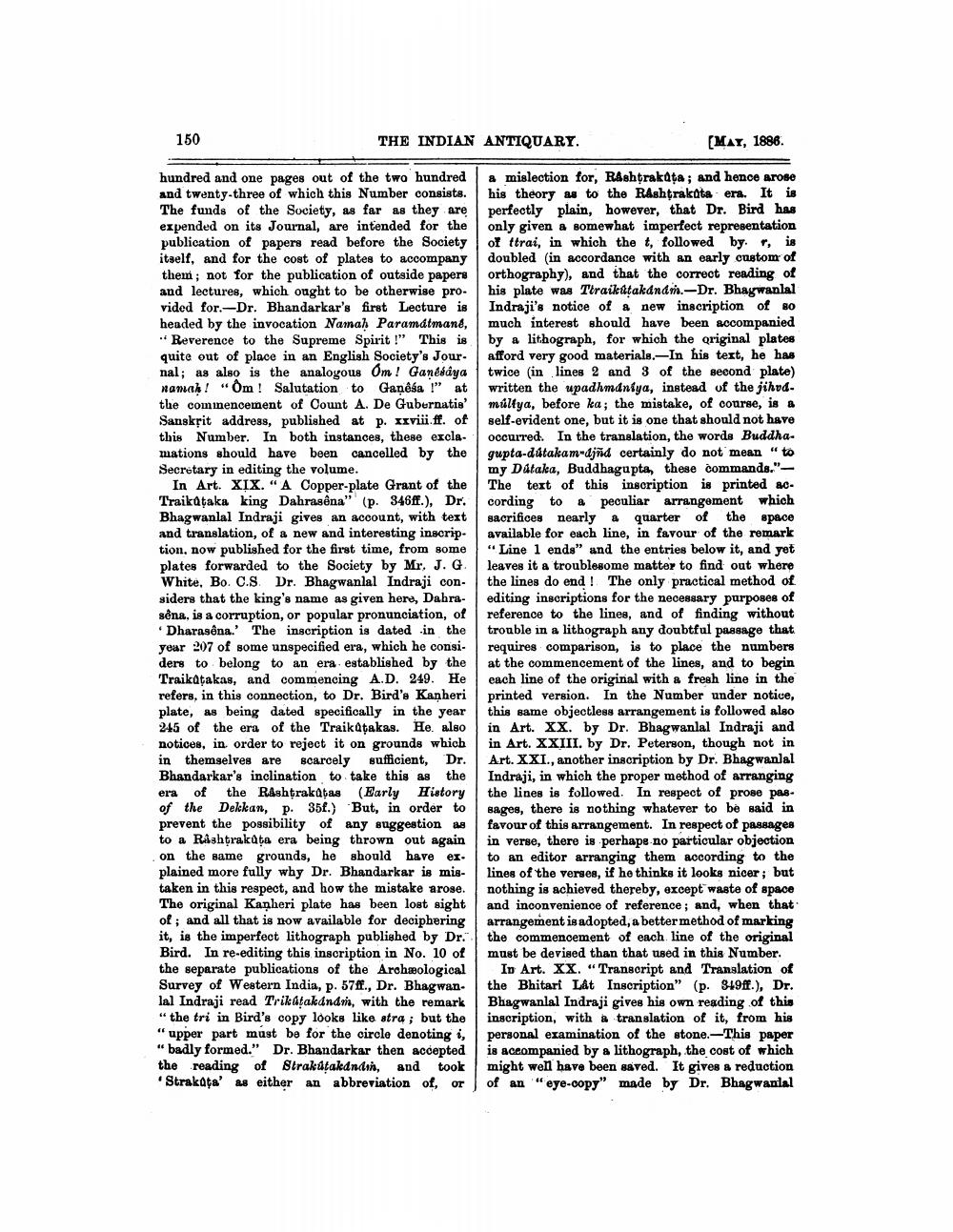________________
150
THE INDIAN ANTIQUARY.
hundred and one pages out of the two hundred and twenty-three of which this Number consists. The funds of the Society, as far as they are expended on its Journal, are intended for the publication of papers read before the Society itself, and for the cost of plates to accompany them; not for the publication of outside papers and lectures, which ought to be otherwise provided for.-Dr. Bhandarkar's first Lecture is headed by the invocation Namaḥ Paramatmané,
Reverence to the Supreme Spirit!" This is quite out of place in an English Society's Journal; as also is the analogous Om! Ganééâya namah! "Om! Salutation to Gaṇeśa!" at the commencement of Count A. De Gubernatis' Sanskrit address, published at p. xxviii.ff. of this Number. In both instances, these excla. mations should have been cancelled by the Secretary in editing the volume.
In Art. XIX. "A Copper-plate Grant of the Traikaṭaka king Dahrasêna" (p. 346ff.), Dr. Bhagwanlal Indraji gives an account, with text and translation, of a new and interesting inscription, now published for the first time, from some plates forwarded to the Society by Mr. J. G. White, Bo. C.S. Dr. Bhagwanlal Indraji considers that the king's name as given here, Dahrasena, is a corruption, or popular pronunciation, of 'Dharasêna.' The inscription is dated in the year 207 of some unspecified era, which he considers to belong to an era established by the Traikaṭakas, and commencing A.D. 249. He refers, in this connection, to Dr. Bird's Kanheri plate, as being dated specifically in the year 245 of the era of the Traikaṭakas. He also notices, in order to reject it on grounds which in themselves are scarcely sufficient, Dr. Bhandarkar's inclination to take this as the era of the Rashtrakutas (Early History of the Dekkan, p. 35f.) But, in order to prevent the possibility of any suggestion as to a Rashtrakuta era being thrown out again on the same grounds, he should have explained more fully why Dr. Bhandarkar is mistaken in this respect, and how the mistake arose. The original Kanheri plate has been lost sight of; and all that is now available for deciphering it, is the imperfect lithograph published by Dr. Bird. In re-editing this inscription in No. 10 of the separate publications of the Archaeological Survey of Western India, p. 57ff., Dr. Bhagwan. lal Indraji read Trikáṭakánám, with the remark "the tri in Bird's copy looks like stra; but the "upper part must be for the circle denoting i, "badly formed." Dr. Bhandarkar then accepted the reading of Strakúṭakandi, and took 'Strakata' as either an abbreviation of, or
[MAY, 1886.
a mislection for, Rashtrakuta; and hence arose his theory as to the Rashtrakuta era. It is perfectly plain, however, that Dr. Bird has only given a somewhat imperfect representation of ttrai, in which the t, followed by. r, is doubled (in accordance with an early custom of orthography), and that the correct reading of his plate was Tiraikuṭakánám.-Dr. Bhagwanlal Indraji's notice of a new inscription of so much interest should have been accompanied by a lithograph, for which the original plates afford very good materials.-In his text, he has twice (in lines 2 and 3 of the second plate) written the upadhmaniya, instead of the jihvdmúltya, before ka; the mistake, of course, is a self-evident one, but it is one that should not have occurred. In the translation, the words Buddhagupta-datakam-djnd certainly do not mean "to my Dátaka, Buddhagupta, these commands."The text of this inscription is printed according to a peculiar arrangement which sacrifices nearly a quarter of the space available for each line, in favour of the remark "Line 1 ends" and the entries below it, and yet leaves it a troublesome matter to find out where the lines do end! The only practical method of editing inscriptions for the necessary purposes of reference to the lines, and of finding without trouble in a lithograph any doubtful passage that requires comparison, is to place the numbers at the commencement of the lines, and to begin each line of the original with a fresh line in the printed version. In the Number under notice, this same objectless arrangement is followed also in Art. XX. by Dr. Bhagwanlal Indraji and in Art. XXIII. by Dr. Peterson, though not in Art. XXI., another inscription by Dr. Bhagwanlal Indraji, in which the proper method of arranging the lines is followed. In respect of prose passages, there is nothing whatever to be said in favour of this arrangement. In respect of passages in verse, there is perhaps no particular objection to an editor arranging them according to the lines of the verses, if he thinks it looks nicer; but nothing is achieved thereby, except waste of space and inconvenience of reference; and, when that arrangement is adopted, a better method of marking the commencement of each line of the original must be devised than that used in this Number.
In Art. XX. "Transcript and Translation of the Bhitari Lât Inscription" (p. 349ff.), Dr. Bhagwanlal Indraji gives his own reading of this inscription, with a translation of it, from his personal examination of the stone. This paper is accompanied by a lithograph, the cost of which might well have been saved. It gives a reduction of an "eye-copy" made by Dr. Bhagwanlal




